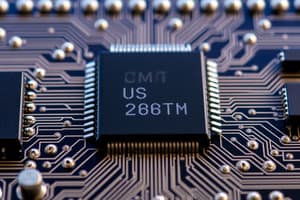Podcast
Questions and Answers
What does the term 'sensitivity' of a sensor indicate?
What does the term 'sensitivity' of a sensor indicate?
- The minimum measurable value of the sensor
- The change in output for a given change in input (correct)
- The maximum output a sensor can produce
- The time taken for the sensor to respond
What is defined as the minimum increment in stimulus that causes a measurable change in output?
What is defined as the minimum increment in stimulus that causes a measurable change in output?
- Sensitivity
- Resolution (correct)
- Response Time
- Transfer Function
Which mathematical representation is often associated with the concept of sensitivity in sensors?
Which mathematical representation is often associated with the concept of sensitivity in sensors?
- $d aT + b = 1$
- $dR = a \, ext{Ω}$
- $R = b + rac{dR}{dT}$
- $dR = a \, dT$ (correct)
What is the primary purpose of calibration methods for sensors?
What is the primary purpose of calibration methods for sensors?
Which concept is closely related to how a sensor reacts over a range of frequencies?
Which concept is closely related to how a sensor reacts over a range of frequencies?
What does resolution indicate in a digital system?
What does resolution indicate in a digital system?
Which term describes the ability of the device to respond to a harmonic input?
Which term describes the ability of the device to respond to a harmonic input?
What is typically measured by the response time of a device?
What is typically measured by the response time of a device?
What does calibration determine in a sensor or actuator?
What does calibration determine in a sensor or actuator?
Which design parameter indicates the narrow range of frequencies over which the device effectively operates?
Which design parameter indicates the narrow range of frequencies over which the device effectively operates?
What represents the phenomenon of a device stabilizing its output after a change in input?
What represents the phenomenon of a device stabilizing its output after a change in input?
Which of the following best characterizes cutoff frequencies?
Which of the following best characterizes cutoff frequencies?
Which response time is typically more desirable in devices?
Which response time is typically more desirable in devices?
Which method is commonly used to establish nonlinearity of a sensor?
Which method is commonly used to establish nonlinearity of a sensor?
What does deadband refer to in a device's response to input?
What does deadband refer to in a device's response to input?
Why is output impedance significant in sensor interfacing?
Why is output impedance significant in sensor interfacing?
Which keyword describes the stability of a sensor to produce consistent readings under identical conditions?
Which keyword describes the stability of a sensor to produce consistent readings under identical conditions?
What does the term 'transfer function' refer to in the context of sensors?
What does the term 'transfer function' refer to in the context of sensors?
Which aspect is NOT directly related to a sensor's calibration?
Which aspect is NOT directly related to a sensor's calibration?
How is reliability defined in the context of sensor performance?
How is reliability defined in the context of sensor performance?
Which factor can influence the frequency response of a sensor?
Which factor can influence the frequency response of a sensor?
Flashcards are hidden until you start studying
Study Notes
Resolution
- Defined as 1/2^N, where N is the number of bits in a digital system.
- Represents the minimum increment of stimulus detectable by the sensor.
Frequency Response
- The ability of a device to respond to sinusoidal inputs.
- Plots magnitude as a function of frequency, highlighting usable stimulus ranges for sensors and actuators.
- Important design parameters include:
- Bandwidth (B-A, in Hz)
- Flat frequency range (D-C, in Hz)
- Cutoff frequencies (points A and B, in Hz)
- Resonant frequencies
Frequency Response Examples
- Bandwidth ranges from 70 Hz to 16.5 kHz, totaling 16.43 kHz.
- Flat frequency range extends from 10 kHz to 120 Hz, with a span of 9880 Hz.
- Cutoff frequencies identified at 70 Hz and 16.5 kHz.
- Resonance occurs at a frequency of 12 kHz.
Response Time
- Indicates the duration required for output to reach steady state after input changes.
- Typically assessed as the time to reach 90% of the steady state output.
- Influenced by both mechanical and electrical inertia of the device.
- Fast response times are preferred, while slow times may result in averaged readings.
Calibration
- Entails experimental determination of a sensor's transfer function.
- Often necessary when transfer function is unknown or operation requires tighter tolerances.
- Typically expressed in hours/years or Mean Time Between Failures (MTBF).
- Manufacturer usually provides calibration based on accelerated lifetime testing.
Sensitivity
- Defined as the change in output corresponding to a unit change in input.
- Represents the slope of the transfer function.
- Can indicate sensitivity to other environmental factors, such as temperature changes affecting resistance measurement.
Deadband
- Characterized by a lack of response within a specific input range where output remains constant.
- Indicates insensitivity that should not induce operation unless acceptable.
Output Impedance
- Defined as the ratio of output voltage to short-circuit current at the output port.
- Essential for interfacing devices; for example, a 500 Ω sensor's output impedance may interface differently with processors depending on their input impedance.
Repeatability
- Also known as reproducibility; denotes the sensor's ability to provide the same output under identical conditions over time.
- Expressed as a percentage of the input full scale, measuring the maximum difference between readings taken at different times.
Reliability
- Statistical measure indicating the quality of a device's operational capability under normal conditions.
- Reflects performance without failure over a specified time or number of cycles.
Studying That Suits You
Use AI to generate personalized quizzes and flashcards to suit your learning preferences.




